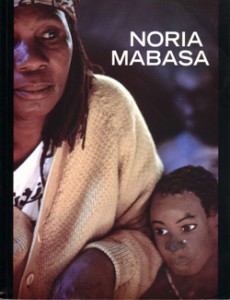TAXI-007 NORIA MABASA was published by David Krut Publishing in association with the French Institute of South Africa, the Royal Netherlands Embassy, Pro-Helvetia, the Swiss Agency for Development and Cooperation and the National Arts Council (NAC).
Noria Mabasa is an artist based in Limpopo province, north of Johannesburg. She is a sculptor of large woodcarvings and figurative ceramic work who first came to prominence in the urban art scene in the mid 1980s. Her extraordinary sculptures inspired by dreams and visions of her ancestors, were included in the first Johannesburg Biennale and she was most recently awarded the order of the grand counsellor for her achievements in art under difficult circumstances.
The book is in full colour, with essays by Dr. Rayda Becker, the curator of the Parliamentary Art Collection, Cape Town and previously associate professor in the History of Art and Fine Arts department at UNISA, and Kathryn Straughan, who runs the Lesheba Wilderness Arts Programme in Limpopo where Noria Mabasa teaches.
The book consists of 95 pages with 48 pages of colour images. Essays by Dr. Rayda Becker and Kathryn Straughan, edited by Karen Press. Softcover. French / Dutch translations
Wilhelm van Rensburg is the author for the educational supplement published with TAXI-007 Noria Mabasa.
EXTRACT FROM THE BOOK
Journey to Venda
Noria Mabasa’s home is in Venda, a region in the north-eastern part of South Africa where most of the inhabitants live in the valleys between high, mist-shrouded mountains. They have many tales and legends about their people and their origins, as well as about the land itself. Noria lives in the village of Tshino which, like other villages in the region, is filled with housing settlements (midi) where each home is surrounded by hedges and low mud walls. Huts are thatched and some are painted with traditional designs. The chief (khasi) of the village has his home on the highest ground, with his wives and family living just below him. The rest of the villagers occupy the surrounding lower areas. In Venda society the household group (mudi), comprises either a single family or a collection of families, usually belonging to the same clan. The inhabitants of the mudi live together in a closely arranged collection of huts, each with its own surrounding courtyard (muta). Each individual household is known as a khoro. The traditional round houses in Tshino are interspersed with modern brick houses. People mill around – women with babies tied to their backs with colourful blankets, men sitting in the shade of trees, smoking tobacco and drinking homemade marula beer, mongrel dogs slinking between legs searching for scraps and chickens scratching and pecking at the ground.
A large rust-coloured metal gate, flanked by two sculptured pillars, and a high fence, unusual in this rural setting, surround the property where Noria lives and works. Her open-air ‘studio’ lies beneath an old mulberry tree where Union Buildings, her latest work, stands covered with yellow plastic sheets. Other large works in progress can be seen lying around. Surrounding the studio area are her maize fields, orchards and vegetable garden.
On the banks of the Luvuvhu River, where women wash their clothes on the rocks and children splash in the water, Noria has built her home. Her property is a fusion of traditional Venda culture and Western influence. Round thatched huts painted with customary designs and a conventional rectangular house with metal frame windows surround a central courtyard. A low wall, stained with red oxide and intricately decorated with throne-like seats and clay statues, encircles this area. One of the huts functions as a bed-and-breakfast facility and another as a workshop where she stores and creates her clay pieces. There is also a small tin-roofed gallery and shop outside the complex, where Noria keeps a selection of her completed works and beadwork that her daughter produces. She and her family live in the Western-style house which has running water and electricity, luxuries in this community.
Two clay figures, one male and one female, stand at the entrance to the courtyard. Noria recreates these bas-relief sculptures on an annual basis. Her art is everywhere. Nubile maidens lie down in the position of respect, vha a losha, sacred crocodiles bask in the sun, lions keep watch and pot plant holders in the shape of the female body are filled with succulents. This is her domestic space, the centre of her private life.
‘If I start to work with clay or wood, I don’t see anything. Then as I start it comes to me here [points at her head] and then it’s coming and coming and I don’t know how, but it is wonderful and the piece becomes something …’
This is Noria, the beautiful dreadlocked mother, grandmother, carver, potter and teacher. When people see her works they are surprised by her humility and her joy in the reaction her pieces inspire, for she too is astonished by what she has made. Noria makes a big impact on those who meet her for the first time. She has not cut her hair since 1989 and wears it long, with the top covered by a scarf or woollen hat. In a dream she was told that every time she cut her hair, she cut her creativity. She fervently believes this and if one dreadlock breaks, she ties it back on. She says, ‘If I cut my hair, art is gone and I get sick …’
DETAILS OF BOOK
Authors : Dr. Rayda Becker and Kathryn Straughan
Editor: Karen Press
Design and layout: Welma Odendaal
Publisher: David Krut Publishing
French Translator: Catherine Lauga du Plessis
Dutch Translator: Loes Nas
Printing: Megadigital
Paper: Millenium Matt 137 gsm
ISBN 0-9584496-5-1
© The authors, the artist, and David Krut Publishing, 2002
ENQUIRIES
TAXI-007: Noria Mabasa, available through David Krut Publishing

